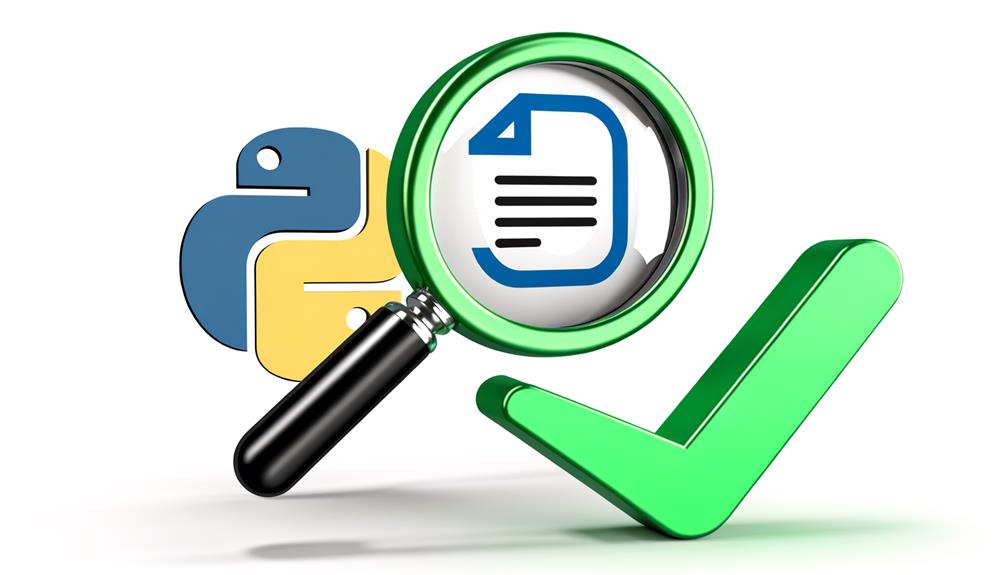To verify and test a Robots.txt file using Python, we tap into libraries such as Advertools and Reppy. Advertools lets us test multiple URLs and user-agents efficiently, providing detailed analyses and data frames for improved crawl efficiency. Reppy extends functionality, offering insightful controls. Through Python, we can interpret directives within robots.txt files, optimize crawling, and identify potential errors affecting website visibility and traffic. By further exploring this topic, you'll gain detailed insights into refining your SEO strategy through an effective use of robots.txt files in the Python environment.
Key Takeaways
- Use Python libraries like Advertools and Reppy to analyze and test robots.txt files for crawl efficiency.
- Advertools can test multiple URLs and user-agents, creating detailed data frames for further analysis.
- Reppy provides additional control and insights, aiding in interpreting the directives in robots.txt files.
- With these tools, identify and correct errors in your robots.txt files that may obstruct search engine bots and affect site visibility.
- Comparing your robots.txt files with those of other sites can help refine your SEO strategy and optimize bot access control.
Understanding Robots.txt Files
Let's dive into understanding robots.txt files, the critical text files that dictate how search engine spiders should interact with the pages and files of your website during their crawling and indexing processes. We'll start with the robots.txt syntax, a fundamental aspect of these text files. The syntax is quite simple, comprising of "User-agent" directives followed by "Disallow" and "Allow" rules. These rules help us specify which parts of our website we want search engine bots to crawl and which to avoid. This, in turn, has a direct impact on crawl efficiency. An optimized robots.txt file ensures that bots spend their time crawling valuable, permissible content rather than wasting resources on sections we'd rather they stay away from.
Importance of Robots.txt Verification

Verifying the accuracy and effectiveness of our robots.txt files is a crucial step in optimizing our website's interaction with search engine bots. This process is vital for two main reasons: website indexing and access control. An incorrect robots.txt file can obstruct search engine bots, leading to issues with website indexing. This could result in our site not appearing in search results, negatively impacting our online visibility and traffic. Additionally, robots.txt files act as gatekeepers, controlling bot access to specific areas of our site. Without proper verification, we may unintentionally grant or deny access to bots in areas we didn't intend. Therefore, we must regularly test and verify our robots.txt files to ensure optimal website performance and visibility.
Python Libraries for Testing Robots.txt

To efficiently test and analyze our robots.txt files, we can leverage powerful Python libraries such as Advertools and Reppy, both of which offer comprehensive functionalities for this task. Advertools allows us to test multiple URLs and user-agents, creating a detailed data frame for further analysis. This Python automation brings great scalability to our testing process, enhancing crawl efficiency significantly. On the other hand, the Reppy library provides additional functionalities, giving us more control and insights into our robots.txt files. By combining the capabilities of both these libraries, we can refine our testing procedures, effectively addressing any potential issues in our robots.txt files that might hamper crawl efficiency and overall website performance.
Analyzing Robots.Txt With Python

Harnessing the power of Python, we can delve into the analysis of robots.txt files, uncovering important insights into the rules governing access to our website content. By utilizing Python libraries like Advertools and Reppy, we're able to interpret the directives in these files, gaining a greater understanding of how web crawlers interact with our site. This analysis is vital for improving crawl efficiency. We can identify any unnecessary barriers to website access and optimize our robots.txt files to guide crawlers efficiently through our content. Moreover, we can highlight any errors which might be affecting our site's visibility. Through diligent analysis, we're able to ensure that our website's access rules are properly configured, enhancing its discoverability and performance.
Comparing Robots.txt Files

Building on our analysis of individual robots.txt files, we can further refine our SEO strategy by comparing these files across different websites. This process helps to identify the best practices in setting up website access restrictions and robots.txt rules.
Here's a simple comparison of three hypothetical sites:
| Website | Crawler Access | Special Directives |
|---|---|---|
| Site A | Allows all | None |
| Site B | Disallows certain paths | Crawl-delay |
| Site C | Disallows all | None |
Site A's robots.txt allows full access, Site B restricts certain sections, using a crawl-delay directive for efficient crawling, and Site C blocks all crawlers. By comparing these, we can determine the most effective rules for our website's robots.txt file, optimizing our site's visibility and crawlability.
Improving SEO Tasks With Python

Leveraging Python's flexibility for testing robots.txt files, we can enhance our SEO tasks, customizing the process to our specific needs and improving our website's visibility. Python automation tools, like Advertools and Reppy, allow us to conduct rigorous, detailed analysis of our robots.txt files. With these tools, we can identify and correct potential errors that could hinder search engine crawlers, thus optimizing our website's visibility. Furthermore, these libraries help us understand complex access rules and manage server bandwidth more efficiently. This in-depth understanding of our site's accessibility, combined with Python's automation capabilities, enables us to perform SEO tasks faster and more accurately. Ultimately, Python's versatility in handling robots.txt files is a powerful asset in our SEO toolkit.
Testing Patterns for Robots.txt

Delving into testing patterns for robots.txt files, we find that establishing a systematic approach can significantly streamline our SEO projects and boost our website's visibility on search engines. Through Python libraries such as Advertools and Reppy, we can simulate different scenarios, testing multiple URLs and user-agents in a succinct manner. This allows us to methodically analyze and optimize robots.txt access control to maximize crawl efficiency. We can effectively manage server bandwidth by adjusting crawl rate and crawl delay parameters, leading to improved crawl efficiency optimization. Moreover, errors in the robots.txt file, which may deter search engines from indexing our pages, can be easily spotted and rectified. This systematic testing ensures our website is fully accessible to web crawlers, enhancing our SEO efforts.
Future of Robots.txt and Python in SEO

As we consider how Python has made testing and verification of robots.txt files more efficient and accurate, it's exciting to ponder the future of this powerful combination in the realm of SEO. We anticipate the evolution of SEO to be heavily influenced by the automation capabilities offered by Python. The continuous advancements in Python libraries for robots.txt testing signal a future where Python isn't just useful, but a standard requirement for SEO professionals. We foresee enhanced capabilities for analyzing and interpreting robots.txt files, providing deeper insights for SEO strategies. The future holds an active collaboration and contributions to improve these Python tools, ultimately shaping how we understand and implement SEO practices. This is the future of SEO – powered by Python and robots.txt.
Frequently Asked Questions
What Specific Python Libraries Are Recommended for Robots.Txt Testing?
We'd recommend using Advertools and Reppy for testing robots.txt files. They're Python libraries that play a significant role in SEO tasks. Advertools handle multiple URLs and user-agents, while Reppy offers additional functionalities. Their importance can't be overstated as they ensure proper access control for web crawlers. By using these, we're not only verifying our robots.txt files but also optimizing our website's visibility.
How Can Python Help in Analyzing Multiple Robots.Txt Files Simultaneously?
We're using Python to analyze multiple robots.txt files simultaneously, boosting our efficiency. By leveraging certain Python libraries, we're able to automate the process, saving time and improving accuracy. Python allows us to load and compare multiple robots.txt files at once, providing valuable insights into the SEO structure of various websites. It's a powerful tool that's become integral to our SEO analysis process.
What Are Common Errors to Look for When Verifying a Robots.Txt File?
We often look for common errors in a robots.txt file like syntax mistakes, incorrect use of user-agent, disallow directives, or crawl delays. These errors impact a website's visibility and crawlability. Our troubleshooting techniques include using Python libraries to parse and analyze the file, identifying discrepancies, and rectifying them promptly. It's a detailed, methodical process that ensures our sites remain accessible and optimized for search engines.
How Does the Testing Pattern for Robots.Txt Files Improve SEO Activities?
We've found that a well-tested robots.txt file significantly boosts our SEO optimization strategies. By controlling crawler access, it directly impacts a website's ranking. A meticulous testing pattern for robots.txt files ensures appropriate indexing and avoids unnecessary crawling of irrelevant pages. Regular revisions of this file also help us adapt to changes in website structure or content. Thus, it's evident that robots.txt file testing is a crucial, ongoing task in our SEO activities.
What Is the Expected Future Role of Python in Robots.Txt Testing and Seo?
We're expecting substantial advancements in Python, which will revolutionize robots.txt testing and SEO algorithms. As Python continues to evolve, it'll become an indispensable tool for SEO professionals. We believe Python's flexibility and analytical capabilities will not only simplify robots.txt testing, but also provide in-depth insights into SEO strategies. Its role in automating and refining SEO practices will undoubtedly shape the future of search engine optimization.



